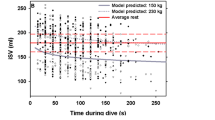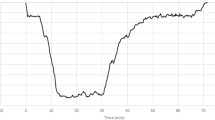Summary
Pressure records from the heart and out-flow vessels of the heart ofCrocodylus porosus resolve previously conflicting results, showing that left aortic filling via the foramen of Panizza may occur during both cardiac diastole and systole. Filling of the left aorta during diastole, identified by the asynchrony and comparative shape of pressure events in the left and right aortae, is reconciled more easily with the anatomy, which suggests that the foramen would be occluded by opening of the pocket valves at the base of the right aorta during systole. Filling during systole, indicated when pressure traces in the left and right aortae could be superimposed, was associated with lower systemic pressures, which may occur at the end of a voluntary aerobic dive or can be induced by lowering water temperature or during a long forced dive. To explain this flexibility, we propose that the foramen of Panizza is of variable calibre. The presence of a ‘right-left’ shunt, in which increased right ventricular pressure leads to blood being diverted from the lungs and exiting the right ventricle via the left aorta, was found to be a frequent though not obligate correlate of voluntary aerobic dives. This contrasts with the previous concept of the shunt as a correlate of diving bradycardia. The magnitude of the shunt is difficult to assess but is likely to be relatively small. This information has allowed some new insights into the functional significance of the complex anatomy of the crocodilian heart and major blood vessels.
Similar content being viewed by others
Abbreviations
- bpm :
-
beats per minute
- LAo :
-
left aorta (aortic)
- LV :
-
left ventricle (ventricular)
- PA:
-
pulmonary artery
- RAo :
-
right aorta (aortic)
- RV :
-
right ventricle (ventricular)
- SC :
-
subclavian artery
References
Ackerman RA, White FN (1979) Cyclic carbon dioxide exchange in the turtle,Pseudemys scripta. Physiol Zool 52:378–389
Anderson HT (1961) Physiological adjustments to prolonged diving in the American alligator. Acta Physiol Scand 53:23–45
Burggren WW (1982) Pulmonary blood plasma filtration in reptiles: a ‘wet’ vertebrate lung? Science 215:77–78
Burggren WW (1985) Hemodynamics and regulation of central cardiovascular shunts in reptiles. In: Johansen K, Burggren WW (eds) Cardiovascular Shunts: Phylogenetic, Ontogenetic and Clinical Aspects. Alfred Benzon Symposium 21. Munksgaard, Copenhagen, pp 121–142
Fritsch G (1869) Zur vergleichenden Anatomie des Amphibien-herzens. Arch Anat Physiol 6:654–758
Gaunt AS, Gans C (1969) Diving bradycardia and withdrawal bradycardia inCaiman crocodilus. Nature 223:207–208
Goodrich ES (1919) Note on the reptilian heart. J Anat 53:298–304
Greenfield LJ, Morrow AG (1961) The cardiovascular hemodynamics of Crocodilia. J Surg Res 1:97–103
Greil A (1903) Beiträge zur vergleichenden Anatomie und Entwicklungsgeschichte des Herzens und des Truncus arteriosus der Wirbeltiere. Morphol Jahrb 31:123–310
Grigg GC, Cairncross M (1980) Respiratory properties of the blood ofCrocodylus porosus. Respir Physiol 41:367–380
Grigg GC, Gruca M (1979) Possible adaptive significance of low red cell organic phosphates in crocodiles. J Exp Zool 209:161–169
Grigg GC, Farwell WD, Kinney JL, Harlow P, Taplin LE, Johansen Kjell, Johansen Kjetil (1985) Diving and amphibious behaviour in a free-livingCrocodylus porosus. Aust Zool 21:599–605
Johansen K (1979) Cardiovascular support of metabolic functions in vertebrates. In: Wood SC, Lenfant C (eds) Evolution of respiratory processes — a comparative approach. Marcel Dekker, New York, pp 107–192
Johansen K (1985) A phylogenetic view of cardiovascular shunts. In: Johansen K, Burggren WW (eds) Cardiovascular shunts: phylogenetic, ontogenetic and clinical aspects. Alfred Benzon Symposium 21. Munksgaard, Copenhagen, pp 17–37
Johansen K, Burggren WW (1980) Cardiovascular function in lower vertebrates. In: Bourne GH (ed) Hearts and heart-like organs. Academic Press, New York, pp 61–117
Khalil F, Zaki K (1964) Distribution of blood in the ventricle and aortic arches in reptilia. Z Vergl Physiol 48:663–689
Messel H, Vorlicek GC, Wells AG, Green WJ (1981) Surveys of tidal river systems in the Northern Territory of Australia and their crocodile populations. Monogr 1. Pergamon Press, Sydney
Panizza B (1833) Sulla structura del cuore e sulla circolazione del sangue delCrocodilus lucius. Biblioth Ital LXX 87:87–91
Sabatier A (1873) Etudier sur le coeur et la circulation centrale dans la série des vertebrés. Ann Sci Nat Zool, Sér V, 18:1–89
Smith EN, Allison RD, Crowder WE (1974) Bradycardia in a free ranging American alligator. Copeia 1974:770–772
Tazawa H, Johansen K (1987) Comparative model analysis of central shunts in vertebrate cardiovascular systems. Comp Biochem Physiol (in press)
Webb GJW (1979) Comparative cardiac anatomy of the reptilia. III The heart of crocodilians and an hypothesis on the completion of the interventricular septum of crocodilians and birds. J Morphol 161:221–240
White FN (1956) Circulation in the reptilian heart (Caiman sclerops). Anat Rec 125:417–432
White FN (1968) Functional anatomy of the heart of reptiles. Am Zool 8:211–219
White FN (1969) Redistribution of cardiac output in the diving alligator. Copeia 1969:567–570
White FN (1970) Central vascular shunts and their control in reptiles. Fed Proc 29:1149–1153
White FN (1976) Circulation. In: Gans C (ed) Biology of the Reptilia, vol 5, Physiology A. Academic Press, London, pp 275–334
White FN (1985) Role of intracardiac shunts in pulmonary gas exchange in chelonian reptiles. In: Johansen K, Burggren WW (eds) Cardiovascular shunts: phylogenetic, ontogenetic and clinical aspects. Alfred Benzon Symposium 21. Munksgaard, Copenhagen, pp 296–309
Wood SC (1984) Cardiovascular shunts and oxygen transport in lower vertebrates. Am J Physiol 247:R3-R14
Wright J (1985) Diving and exercise physiology in the Estuarine Crocodile,Crocodylus porosus. PhD thesis, The University of Sydney, Australia
Author information
Authors and Affiliations
Additional information
Deceased
Rights and permissions
About this article
Cite this article
Grigg, G.C., Johansen, K. Cardiovascular dynamics inCrocodylus porosus breathing air and during voluntary aerobic dives. J Comp Physiol B 157, 381–392 (1987). https://doi.org/10.1007/BF00693365
Accepted:
Issue Date:
DOI: https://doi.org/10.1007/BF00693365




